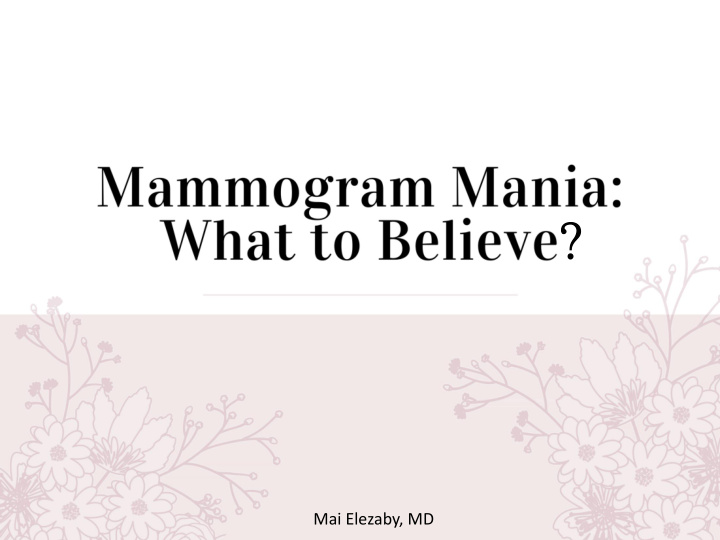



? Mai Elezaby, MD
“Big Picture” Population Prospective
Breast Cancer Most common cancer in women 2 nd leading cause of death U.S. 2016 estimates ▪ 246,660 new cases ▪ 40,450 deaths from breast cancer https://seer.cancer.gov/statfacts/html/breast.html
2016 https://www.dhs.wisconsin.gov/publications/p01573a.pdf
• One in eight women will be diagnosed with breast cancer • ¾ of breast cancers occur in women without family history of breast cancer • One in six breast cancers occur in women in their forties
100 ✓ Smaller size 5-Year Survival (%) 80 ✓ Earlier stage 60 40 20 0 <1 1-1.9 2-2.9 3-3.9 4-4.9 >5 Tumor size (cm) 100 5-Year Survival (%) More likely 80 60 to be curable 40 20 0 0 I IIA IIB IIIA IIIB IIIC IV Stage Surveillance, Epidemiology, and End Results (SEER) Program Results https://www.ncbi.nlm.nih.gov/books/NBK65847/figure/CDR0000257530__268/ Courtesy of Dr. Amy Fowler
100 ✓ Smaller size 5-Year Survival (%) 80 ✓ Earlier stage 60 40 20 0 <1 1-1.9 2-2.9 3-3.9 4-4.9 >5 Tumor size (cm) 100 5-Year Survival (%) SCREENING 80 60 40 20 0 0 I IIA IIB IIIA IIIB IIIC IV Stage Surveillance, Epidemiology, and End Results (SEER) Program Results https://www.ncbi.nlm.nih.gov/books/NBK65847/figure/CDR0000257530__268/ Courtesy of Dr. Amy Fowler
Simple test to identify those who have disease, but do not yet have symptoms Requirements: ▪ Readily available ▪ Low cost ▪ Can differentiate those that have the disease from those who don’t (high sensitivity, acceptable specificity)
100 5-Year Survival (%) 80 60 40 20 0 <1 1-1.9 2-2.9 3-3.9 4-4.9 >5 Tumor size (cm) 100 5-Year Survival (%) 80 60 40 20 0 0 I IIA IIB IIIA IIIB IIIC IV Stage Surveillance, Epidemiology, and End Results (SEER) Program Results https://www.ncbi.nlm.nih.gov/books/NBK65847/figure/CDR0000257530__268/ Courtesy of Dr. Amy Fowler
- 37% Screening Mammography Advancement in Treatments http://seer.cancer.gov/statfacts/html/ld/breast.html Surveillance, Epidemiology, and End Results Program (SEER), Cancer Statistics Review 1975-2013. Courtesy of Dr. Amy Fowler
Can be scheduled without physician referral 20 min visit Images read by radiologist Patients receive summary letter by mail Physician receives formal report
Study Design % Reduction in Breast Cancer Mortality Randomized control trials 20-22% Service screening studies 38-40% Case-control studies 48-49% Computer modeling 46% Fowler AM et al (2016) Society of Breast Imaging News 2:15-18
“ Individual Perspective ” Radiation (minimal) ▪ ~ yearly background radiation if you live in Denver False negative results (does not identify a cancer) ▪ 60% to 90% sensitivity for cancer, depending on a woman’s age and the density of her breasts
“Individual Perspective ” Anxiety ▪ Subjective ▪ Recalls increase baseline anxiety…transient ▪ Patients with family history of breast cancer have lower levels of anxiety Gilbert FJ, Cordiner CM, Affleck IR, Hood DB, Mathieson D, Walker LG. Breast screening: the psychological sequelae of false- positive recall in women with and without a family history of breast cancer. European journal of cancer;34(13):2010-4.
“Individual Perspective” False Positives ▪ Additional imaging/or biopsy, but do not have cancer (benign results) For every cancer averted, 180 women will be called back There is a 1 in 50 chance you will be called back once if you get annual screening mammograms for 10 years
90% Screening Pool (n=900) (n=1000) Negative
90% Screening Pool (n=900) (n=1000) Negative 10% (n=100) Additional imaging (mammogram and ultrasound)
90% Screening Pool (n=900) (n=1000) Negative 10% (n=100) Additional imaging (mammogram and ultrasound) 20% (n=20) Recommend biopsy
90% Screening Pool (n=900) (n=1000) Negative 10% (n=100) Additional imaging (mammogram and ultrasound) 20% (n=20) 30% 5/1000 Cancer
90% Screening Pool (n=900) (n=1000) Negative 10% (n=100) Back to Additional imaging imaging (mammogram and (n=80) ultrasound) False Positive 20% (n=95) (n=20) Benign Recommend biopsy biopsy (n=15) 30% Cancer
Call back Benign cyst Screening exam
“Individual Perspective ” Overdiagnosis- overtreatment ▪ Cancers that are detected/ treated as a result of screening test, will not kill the patient ▪ Unavoidable harm to any screening test (prostate, lung, colon) ▪ Estimates (best guess) is 11% - 19%)
“Individual Perspective ” Overdiagnosis- Overtreatment ▪ In situ-DCIS ▪ Proposes low grade DCIS will not progress ▪ There are currently no reliable individual indicators to guarantee which DCIS will progress and which will not
Benefits Harms
Screening Algorithms for Average risk Mammography Screening Interval Society • Starting at 40 years American College of Radiology (ACR) • Society of Breast Imaging (SBI) Every year (Annual) • The American Congress of Obstetricians and Gynecologists (ACOG) • National Comprehensive Cancer Network (NCCN) American Cancer Society ( NEW ) Baseline mammogram 40-45 Every year 45-55 Once every two years (Biennial) >55 • Individual decision 40-49 United States Preventative Services Task Force (USPSTF) 2009-Draft 2015 Once every two years (Biennial) 50-74 • American College of Family Practice (AAFP)
We do not have the accurate tools to make individual decisions regarding best screening interval Data from prior studies suggest that delaying screening till age 50 years will decrease lives saved by 6,500/year Changing screening recommendations ratings will ultimately affect reimbursement
High risk patients (≥ 20% risk) ▪ Annual Mammography +MRI Moderate risk patients (> 12-<20%) ▪ Annual mammogram + (3D mammography or Ultrasound)
“ Precision Medicine ”
“ Precision Medicine ” ▪ Better screening tools ▪ TMIST: Tomosynthesis Mammography In Screening Trial ↑ ↑ Cancer detection ↓ False positives Digital Breast Tomosynthesis- 3D mammography
“ Precision Medicine ” ▪ Tailored screening intervals based on individual patient risks ▪ WISDOM: Women Informed to Screen Depending On Measures of risk
“ Precision Medicine ” ▪ Tailored treatment options based on individual cancer and patient biology ▪ COMET: Comparing surgery to Endocrine Therapy for Low-risk DCIS
Must guarantee women’s access to basic mammography screening, protecting “ OUR RIGHT to CHOOSE ” Big national studies are on the way to reach the goal of “Precision Medicine” , but… we are not there yet The driving factor in choices in screening should be based on individual preferences on risk-benefit ratio
Emphasis on research to identify patient-specific factors to tailor treatment, rather than limit access to diagnosis
Recommend
More recommend